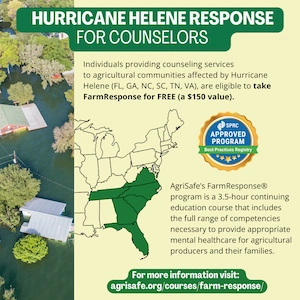Last updated on November 27th, 2024 at 09:24 am
Hurricane Helene and Hurricane Milton have had devastating impacts on the southeastern United States, and communities are facing unprecedented challenges. Many areas have been left in ruins, with communication lines severed, and local support systems struggling to respond. Visit the hyperlinked text to find out how you can help the states of North Carolina, South Carolina, Florida, Tennessee, Georgia, and Virginia.
Being aware of hurricane hazards is crucial, especially if you live in coastal areas or regions prone to tropical storms. Hurricanes can cause extensive damage through high winds, heavy rainfall, and storm surges, posing significant risks to both property and personal safety. Listen to some general post-hurricane safety tips from AgriSafe’s Public Health and Equity Director, Knesha-Rose Davison.
Evacuation Routes
Know your local evacuation routes, and have a plan in place for safe evacuation. Familiarize yourself with local shelters and emergency resources.
Flooding
Heavy rainfall and storm surges can lead to significant flooding. Water may not be safe to drink, cook, or clean with after a flood. Water can become contaminated with microorganisms such as bacteria, sewage, heating oil, agricultural or industrial waste, chemicals, and other substances that can cause serious illness. Find more information on AgriSafe’s flooding page.
Check out AgriSafe’s English Flood Infographics Social Media Toolkit and the Spanish-Language version, Material necesario en caso de inundación.
Additional resource: How to Disinfect Wells After an Emergency – CDC
Health Precautions
After a hurricane, avoid contact with standing water and be cautious of potential hazards such as downed power lines and damaged infrastructure. Ensure that food and water supplies are safe before consumption.
Listen to what Ellen Duysen from the University of Nebraska Medical Center has to say about safe drinking water.
Power Outages
Hurricanes often result in power outages, disrupting communication and access to essential services. Have a backup power source and keep essential supplies on hand.
Wind Damage
Strong winds can uproot trees, damage roofs, and destroy structures. Ensure that your home is well-prepared by securing loose items and reinforcing windows and doors.
Chemicals
If a chemical, pesticide, or hazardous waste spill occurs, chemicals might be released from barns, homes, and other sources into the environment. Chemical spills could release vapors or chemical fumes. Learn more about chemical safety from AgriSafe.
Heat-Related Illnesses
Disaster recovery is physically strenuous, especially in hot temperatures. Intense heat exposure can cause heat-related illnesses. Signs can include excessive thirst, weakness, headache, loss of consciousness, nausea and vomiting, muscle cramps, and/or dizziness.
Livestock
Hurricanes can cause floods which can potentially increase the transmission of communicable diseases: Water-Borne (Hepatitis A); Vector-Borne (West Nile Virus); Bacterial (Tetanus) spores and Fungal (Histoplasmosis) spores found in dust, dirt, animal droppings and animal carcass.
Hear what Dr. Aaron Yoder, from the University of Nebraska Medical Center, has to say about pre-planning for livestock evacuations.
Mental Stress
After a natural disaster, individuals are dealing with the extra stress of current conditions, along with the daily stress of farm and ranch operations. Natural disasters such as hurricanes create a tremendous amount of additional stress and anxiety. It is possible to develop major depression, generalized anxiety, and/or post-traumatic stress disorder. Learn more about mental health from AgriSafe.
Listen to what Dr. Tara Haskins, AgriSafe’s Total Farmer Health® Director, has to say about mental health during natural disasters.
Mold
Mold is part of the natural environment, but higher concentrations of mold and bacteria can be found after a flood. The wet environment can cause the production of Microbial Volatile Organic Compounds (mVOCs), which emit chemical like odors and can become noxious respiratory irritants. Learn more about respiratory health best practices from AgriSafe.
Listen to what Dr. Chad Roy from the Tulane School of Medicine has to say about mold exposure and preventative measures.
Additional resource: What You Can Do to Protect Your Respiratory Health During Disaster Cleanup – CDC
Hurricane Resources
Documents
Webinars
Page updated: October 2024

